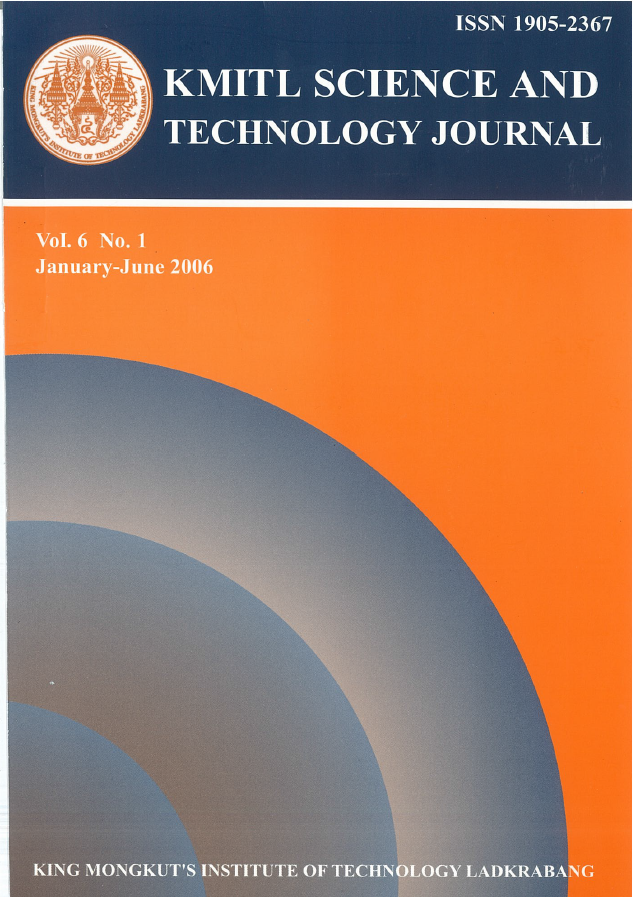Removal of Hexavalent Chromium From Aqueous Solutions By Scrap Iron Filings
Main Article Content
Abstract
Chromium is an important industrial metal used in various products and processes. Hexavalent chromium is relative mobile in the environment and is acutely toxic, mutagenic, teratogenic and carcinogenic. The impacts of chromium on human health and the environment is of wide concern. Therefore, it is imperative that hexavalent chromium be removed from wastewater. A removal of hexavalent chromium using scrap iron filings was studied in both synthetic wastewater, containing 20 mg 1-1 of hexavalent chromium plating wastewater. All experiments were evaluated in batch experiments. Effective conditions for removal of hexavalent chromium were found to be pH of 3, iron particle sizes of 35 - >200 mesh, agitating rate at 250 rpm, contact time at 180 mins., iron dosage of 1 g. According to the experiment results, almost all of hexavalent chromium was transformed to trivalent chromium. Trivalent chromium and total iron in the aqueous solution were then removed by precipitation with alkaline solutions. In this work, sodium hydroxide and calcium hydroxide were used. It was found that the use of sodium hydroxide was more effective than that of calcium hydroxide. The reaction rate constants from the results following first order reaction were calculated. In addition, it was found that nickel and copper in the aqueous solution did not affect on the reduction of hexavalent chromium.
Keywords: chromium plating wastewater, hexavalent chromium, scrap iron filings
Corresponding author: E-mail: kjsuwann@kmitl.ac.th
Article Details
Copyright Transfer Statement
The copyright of this article is transferred to Current Applied Science and Technology journal with effect if and when the article is accepted for publication. The copyright transfer covers the exclusive right to reproduce and distribute the article, including reprints, translations, photographic reproductions, electronic form (offline, online) or any other reproductions of similar nature.
The author warrants that this contribution is original and that he/she has full power to make this grant. The author signs for and accepts responsibility for releasing this material on behalf of any and all co-authors.
Here is the link for download: Copyright transfer form.pdf
References
[2] Sparks, D.L. 1995 Environmental Soil Chemistry. Academic Press, CA, USA.
[3] Orth, W./s. and Gillham, R.W. 1996 Dechlorination of Trichloroethene in Aqueous Solutions using Fe0, Environmental Science and Technology, 30(1), 66-71.
[4] Gotpagar J., Grulke E., Tsang T. and Bhattacharyya, D. 1997 Reductive Dehalogenation of Trichloroethylene using Zero-valent Iron, Environmental Progress, 16(2), 137-143.
[5] Janda, V., Vasek, P., Bizova, J. and Belohlav, Z. 2004 Kinetic Models for Volatile Chlorinated Hydrocarbons Removal by Zero-valent Iron, Chemosphere, 54, 917-925.
[6] Agrawal, A. and Tratnyek, P.G. 1996 Reduction of Nitro Aromatic Compounds by Zero-valent Iron Metal, Environmental Science and Technology, 30(1), 153-160.
[7] Cao, J., Wei, L., Huang, Q., Wang, L. and Han, S. 1999 Reducing Degradation of Azo Dye by Zero-valent Iron in Aqueous Solution, Chemosphere, 38(3), 565-571.
[8] Deng N., Luo F., Wu F., Xiao M. and Wu X. 2000 Discoloration of Aqueous Reactive Dye Solutions in the UV/Fe0 system, Water Research, 34(8), 2408-2411.
[9] Nam, S. and Tratnyek, P.G. 2000 Reduction of Azo Dyes with Zero-valent Iron, Water Research, 34(6), 1837-1845.
[10] Mielczarski, J.A., Atenas, G.M. and Mielczarski, E. 2005 Role of Iron Surface Oxidation Layers in Decomposition of Azo-Dye Water Pollutants in Weak Acidic Solutions, Applied Catalysis B: Environmental, 56, 289-303.
[11] Lee, T., Lim, H., Lee, Y. and Park, J-W. 2003 Use of Waste Iron Metal for Removal of Cr(VI) from Water, Chemosphere, 53, 479-485.
[12] Puls, R.W., Paul, C.J. and Powell, R.M. 1999 The Applicationof in situ Permeable Reactive (Zero-valent Iron) Barrier Technology for the Remediation of Chromate Contaminated Groundwater: A Field Test, Applied Geochemistry, 14, 989-1000.
[13] Blowes, D.W., Ptacek, C.J. and Jambor, J.L. 1997 In-situ Remediation of Cr(VI) Contaminated Groundwater using Permeable Reactive Walls: Laboratory Studies, Environmental Science and Technology, 31(12), 3348-3357.
[14] Buerge, I.J. and Hug, S.J. 1997 Kinetics and pH Dependence of Chromium(VI) Reduction by Iron (II), Environmental Science and Technology, 31(5), 1426-1432.
[15] Buerge, I.J. and Hug, S.J. 1999 Influence of Mineral Surfaces on Chromium(VI) Reduction by Iron(II), Environmental Science and Technology, 33(23), 4285-4291.
[16] Ponder, S.M., Darab, J.G. and Mallouk, T.E. 2000 Remediation of Cr(VI) and Pb(II) Aqueous Solutions using Supported, Nanoscale Zero-valent Iron, Environmental Science and Technology, 34(12), 2564-2569.
[17] Nikolaidis, N.P., Dobbs, G.M. and Lackovic, J.A. 2003 Arsenic Removal by Zero-valent Iron: Field, Laboratory and Modeling Studies, Water Research, 37, 1417-1425.
[18] ASTM 1998 ASTM D 1687-92, Test methods for Chromium in Water.
[19] Lin, Q., Zhao, G. and Yuan, W. 1990 Chemical Equilibrium Calculation in Treatment of Wastewater Containing Chromium, Water Treatment, 4, 79-90.
[20] Department of Industrial Works 1999 Chromium Plating Wastewater.
[21] Hanpongoun, I. 1996 General Chemistry for Engineers, 6th eds., Bangkok, Chulalongkorn Publishing.


